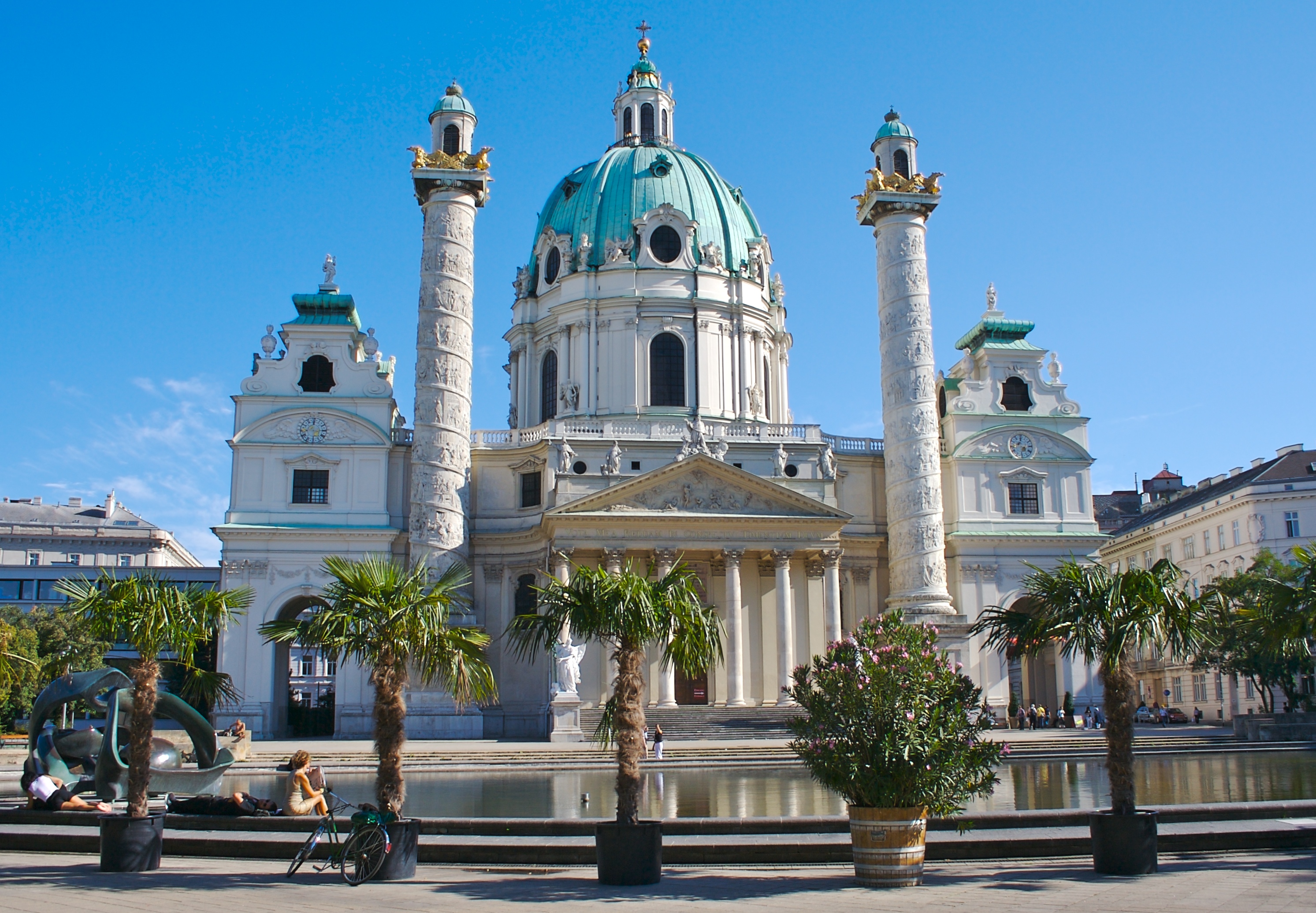- Karlskirche
Infobox religious building
building_name= Church of St. Charles Borromeo
caption= Karlskirche
location=Vienna ,Austria
geo = coord|48|11|54|N|16|22|17|E|display=inline|region:AT_type:landmark
religious_affiliation=Roman Catholic
rite=
province=
district=
consecration_year=
status=
leadership= P. Milan Kucera O.Cr. [http://www.karlskirche.at/pfarre.html Official Website of Pfarre St. Karl Borromäus] ]
website= [http://www.karlskirche.at/ Official Website]
architect=Johann Bernhard Fischer von Erlach ,Joseph Emanuel Fischer von Erlach
architecture_type= Church cite web |url=http://stephanscom.at/pfarren/dekanate/Stadtdekanat_4_5/St._Karl_Borrom%E4us
title= Pfarre St. Karl Borromäus|accessmonthday=11-12 |accessyear=2007
author= |date= |language=German |publisher= Erzdiözese Wien]
architecture_style=BaroqueRococo
facade_direction= NNW
year started=1716
year_completed=1737
construction_cost=
capacity=
length= 55 m
width=40 m
width_nave=
height_max=
dome_quantity= 1
dome_height_outer= 70 m
dome_height_inner=
dome_dia_outer=
dome_dia_inner=
materials=The Karlskirche (German for "St. Charles's Church") is a church situated on the south side of
Karlsplatz ,Vienna . It is located on the edge of the 1st district, 200metre s outside theRingstraße . It is one of the most outstanding baroque church structures north of theAlps , and boasts adome in the form of an elongatedellipsoid .Ever since Karlsplatz was restored as an ensemble in the late 1980s, the Karlskirche has garnered fame due to its dome and its two flanking columns of
bas-relief s, as well as its role as an architectural counterweight to the buildings of the Musikverein and of theVienna University of Technology .The church is cared for by a religious order and has long been the
parish church as well as the seat of the Catholic student ministry of the Vienna University of Technology.Design and construction
In 1713, one year after the last great plague
epidemic ,Charles VI, Holy Roman Emperor , pledged to build a church for his namesake patron saint,Charles Borromeo , who was revered as a healer for plague sufferers. Anarchitectural competition was announced, in whichJohann Bernhard Fischer von Erlach prevailed over, among others,Ferdinando Galli-Bibiena andJohann Lukas von Hildebrandt . Construction began in 1716. After J. B. Fischer's death in 1723, his son,Joseph Emanuel Fischer von Erlach , completed the construction in 1737 using partially altered plans. The church originally possessed a direct line of sight to theHofburg and was also, until 1918, the imperial patron parish church.As a creator of historic architecture, J. B. Fischer united the most diverse of elements. The façade in the center, which leads to the porch, corresponds to a
Greek temple portico . The neighboring two columns, crafted byLorenzo Mattielli , found a model inTrajan's Column inRome . Next to those, two tower pavilions extend out and show the influence of the Roman baroque (Bernini and Borromini). Above the entrance, adome rises up above a high drum, which the younger J. E. Fischer shortened and partly altered.Iconography
The iconographical program of the church originated from the imperial official
Carl Gustav Heraeus and connects St. Charles Borromeo with his imperial benefactor. Therelief on thepediment above the entrance with thecardinal virtues and the figure of the patron on its apex point to the motivation of the donation. This sculpture group continues onto the attic story as well. The attic is also one of the elements which the younger Fischer introduced. The columns display scenes from the life of Charles Borromeo in aspiral relief and are intended to recall the twup columns, Boaz and Jachim, that stood in front of the Temple at Jerusaelm. They also recall thePillars of Hercules and act as symbols of imperial power. The entrance is flanked by angels from the Old andNew Testament s.This program continues in the interior as well, above all in the dome
fresco byJohann Michael Rottmayr of Salzburg andGaetano Fanti (pseudoarchitecture ) which displays an intercession of Charles Borromeo, supported by the Virgin Mary. Surrounding this scene are the cardinal virtues. The frescos in a number of side chapels are attributed toDaniel Gran .The high altar painting portraying the ascension of the saint was conceptualized by the elder Fischer and executed by
Ferdinand Maximilian Brokoff . The altar paintings in the side chapels are by various artists, including Daniel Gran,Sebastiano Ricci ,Martino Altomonte andJakob van Schuppen .As strong effect emanates from the directing of light and architectural grouping, in particular the arch openings of the main axis. The color scheme is characterized by
marble with sparring and conscious use of gold leaf. The large round glass window high above the main altar with the HebrewJehova Tetragram symbolizes God'somnipotence and simultaneously, through its warm yellow tone, God's love.Next to the structures at
Schönbrunn Palace , which maintain this form but are more fragmented, the Karlskirche is Fischer's greatest work. It is also an expression of the Austrian "joie de vivre" stemming from the victorious end of the Turkish Wars.Notes
References
*cite book | last = Charpentrat| first = Pierre | authorlink = | title = Living Architecture: Baroque| publisher = Oldbourne| year = 1967 | oclc = 59920343 | pages = 91
*cite book | last = Clark | first = Roger | title = Precedents in Architecture | publisher = Van Nostrand Reinhold | location = New York | year = 1985 | pages=165 & 208 |isbn = 0442216688
*cite book | last = Trachtenberg | first = Marvin| coauthors = Hyman, Isabelle | title = Architecture: from Prehistory to Post-Modernism | publisher = Prentice-Hall | location = Englewood Cliffs | year = 1986 | isbn = 0130447021 |pages=370-1
Wikimedia Foundation. 2010.
